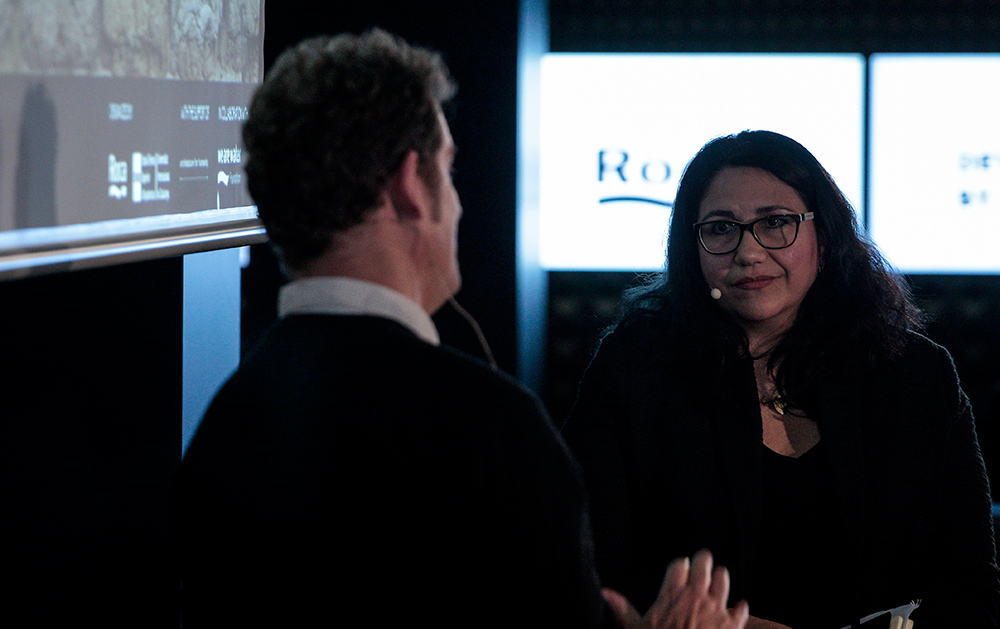
Last Thursday, in collaboration with Roca, we kicked off our new conference series Development by Design: Dialogues in Architecture, Equity and Design with our first guest, Nathaniel Corum of Architecture for Humanity.
As host and interviewer, our program’s codirector Carmen Mendoza began the conversation by clearing the air about Architecture for Humanity’s recent closure amid financial stress and irregularities.
“The structure of philanthropy [in architecture and design] has changed,” Nathaniel explained. “Whereas before there were only a handful of organizations devoted to that kind of work, now a lot of architecture firms have their own initiatives. While Architecture for Humanity wasn’t perfect, it was instrumental in making this happen. And that alone is a kind of success.”


In illustrating the key concepts and processes behind regenerative design, Nathaniel took us through some of his projects, each of them set in a a specific geographical context: Desert, Mountain, Island and Ocean.
While Nathaniel’s ocean-based project building a cabin for the Plastiki got him a lot of exposure, it is his work with indigenous communities that characterizes the bulk of his work. This includes post-disaster reconstruction with coastal fishermen in places like Japan after the Tohoku earthquake, and community facilities and design/build programs in Mexico and Haiti. Perhaps Nathaniel’s most notable work lies with Native American communities, creating culturally-appropriate, off-the-grid housing initiatives for this quietly discriminated minority in “what is now called the United States,” as he always puts it.
But what is relevant to preserve when it comes to culture? As Carmen pointed out, the erosion of culture is a complex phenomenon that often leads to new or evolved cultural identities that need to be considered when dealing with preservation. “We don’t want to get stuck in the past,” Nathaniel agreed. “It’s really all about deep listening, and finding out what it is that people want. A lot of times the cultural protocols desired by the tribal members are then embedded within a modern design.” In American Indian communities, these protocols include things like circular layouts, eastern-facing entries, communal kitchens, open spaces for celebration, and interior areas that open onto exterior ones.


Carmen also talked to Nathaniel about measuring the impact of projects. Aside from revisiting them to see how they’ve evolved, Nathaniel says he looks to the local press to gauge how the communities themselves have received the project, which stands as a far more reliable source of praise or constructive criticism than what international coverage or general architecture blogs often provide.
Now that the Architecture for Humanity chapter in Nathaniel’s career has come to a close, he will continue his work with Sustainable Native Communities Collaborative, as well as collaborating with several other organizations, including Brad Pitt’s Make it Right Foundation building efficient homes for low-income residents at a Montana reservation.

When asked about the repercussions of the growing trend in celebrity-led NGOs, Nathaniel said it wasn’t all black or white. “Sure you get cases of personal green-washing, but other times the effort are earnest. The reality is it’s happening, and architects and designers can bring in density of fact to make the endeavor a productive one.”
The most significant danger, he pointed out, is how celebrity-funding can sabotage communtity engagement, causing community members to see it as an easy handout rather than owning the project and working to make it happen. “As architects, designers or organizations we don’t want to ‘give’ people houses. We want to bring them equity. Actually, I think it would better if celebrities remained anonymous until, say, 2 years after the project is completed, regardless of its success or failure. Maybe we should start putting that into the contract somewhere.”
As for the role of architects today, Nathaniel likens them to “directors of play,” in the way they must bring together and choreograph a team of actors. In this case, it is a transdisciplinary one whose mission of sustainability should not only signify getting by as a human race, but thriving as one.
More photos from the event:





Join us for our next dialogue February 10th with special guest Esteban Leon of UN-Habitat who will talk about Resilience in Development. Stay tuned for updates through Facebook and Twitter.
All photos of the event ©Roca Barcelona Gallery

